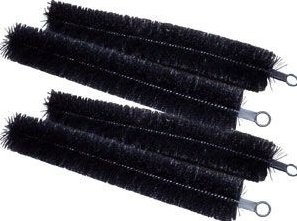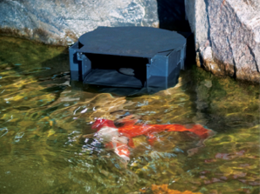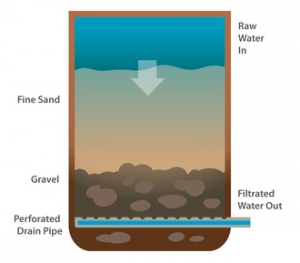In his enlightening missive regarding the concept of Living Water, the much-respected Laguna Koi Ponds’ Ben Plonski talks about the added benefits of installing a pre-filter. He posits that:
A good pre-filter prevents solids from reaching the pump and biofilter. Now you can clean the pre-filter without disturbing the biofilter bacteria. The biofilter bacteria are very slow growing and are easily lost in vigorous frequent cleaning. A good filter system would require weekly cleaning of a pre-filter and cleaning the biofilter once or twice a year!
What is a Pre-filter?
It is exactly what it sounds like. It is a mechanical filter that is situated somewhere ahead of your main biological filtration system to aid in removing as much solid waste (undigested food, organic debris—leaves, twigs, sticks—and string algae) as possible BEFORE it reaches the biofilter.
What it does?
It’s main function is to keep solids out of your pump and from clogging up the biological filter. Water is drawn from the pond’s surface (like a skimmer) or through a bottom drain where the pre-filter acts like a collection point for large organic and inorganic material.
As water passes through the pre-filter, it is strained and the almost completely debris-free water is then pumped to the biological filter where the water has the koi waste by-product (ammonia) cleaned by beneficial bacteria.
Types of Pre-filters
There are different types of pre-filters that are common to koi ponds.
 Holding Tank
Holding Tank
The simplest is the holding tank where a system of mats or brushes are placed in rows or levels in the tank to remove solids and debris as the pond water flows over or through them before they are pumped into the biological filter. The brushes and mats have to be routinely cleaned.
 Skimmer
Skimmer
The skimmer is akin to the holding tank. They are placed at a point (or points) around the surface of the pond where water flows into and the floating debris is captured and manually removed while the water flows down into the pump and biofilter.
Vortex
The Vortex system is one where the water is pumped into the bottom of a tapered cylinder-shaped housing (usually off to one side) where the water is propelled at higher volumes against the side of cylinder to create a vortex. The heavier material then falls to the bottom where it is backwashed out. Some of the models can be bulky, thereby taking up some more space.
Benefits of a Pre-filter
Beyond simply stopping things like stones, leaves, sticks, algae and general goop from getting into your pump or bio-filter it can also:
- Reduce stress on pump impeller
- Add to pump life expectancy
- Increase overall water flow in the pump
- Stop smaller fish/invertebrates from being sucked into the pump
- Higher efficiency/effectiveness in the biological filter
 Sand
Sand
Sand filters are common, and act as both a mechanical and biological filter with the fine sand acting as a media for harboring the growth of beneficial bacteria as well as being compact enough to trap larger waste from getting back into the pump. The debris is then routinely backwashed out of the filter.
 Bead
Bead
Bead filters use a similar principle to the sand filter with the same capacity for growing beneficial bacteria on the small beads while capturing large debris. The difference is that process is inverted with the material being forced upwards to be trapped by the beads instead of relying on gravity. The waste and solids are then eliminated via backwashing and syphoning any sludge from a bottom drain.
In some instances, koi keepers will use a pre-filter to help minimize the strain on the biological filter—and even help with the load—so that it has the opportunity to maximize its capacity for breaking down ammonia.
Which type of pre-filter will prove to be most effective is usually determined by the size of the pond. There is a lot of debate about which type or model works the best, but ultimately any filter that is effective in minimizing or reducing solid debris is a good idea.
We’ll finish this off the same we started it with a quote from Ben Plonski:
Get the right filter design and you will be in charge.

